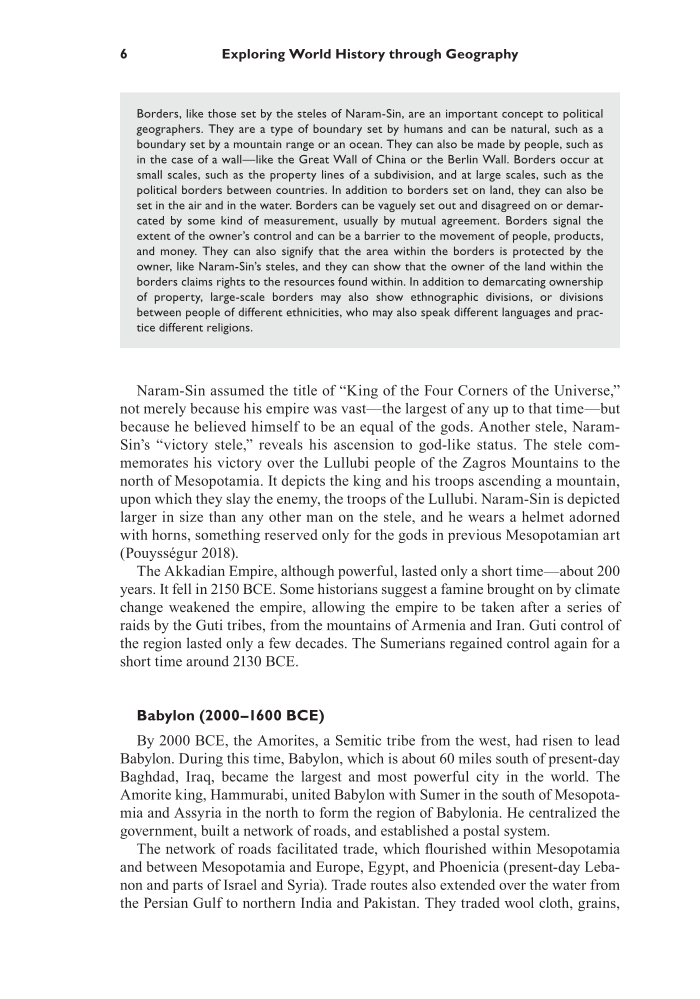6 Exploring World History through Geography Naram-Sin assumed the title of “King of the Four Corners of the Universe,” not merely because his empire was vast—the largest of any up to that time—but because he believed himself to be an equal of the gods. Another stele, Naram- Sin’s “victory stele,” reveals his ascension to god-like status. The stele com- memorates his victory over the Lullubi people of the Zagros Mountains to the north of Mesopotamia. It depicts the king and his troops ascending a mountain, upon which they slay the enemy, the troops of the Lullubi. Naram-Sin is depicted larger in size than any other man on the stele, and he wears a helmet adorned with horns, something reserved only for the gods in previous Mesopotamian art (Pouysségur 2018). The Akkadian Empire, although powerful, lasted only a short time—about 200 years. It fell in 2150 BCE. Some historians suggest a famine brought on by climate change weakened the empire, allowing the empire to be taken after a series of raids by the Guti tribes, from the mountains of Armenia and Iran. Guti control of the region lasted only a few decades. The Sumerians regained control again for a short time around 2130 BCE. Babylon (2000–1600 BCE) By 2000 BCE, the Amorites, a Semitic tribe from the west, had risen to lead Babylon. During this time, Babylon, which is about 60 miles south of present-day Baghdad, Iraq, became the largest and most powerful city in the world. The Amorite king, Hammurabi, united Babylon with Sumer in the south of Mesopota- mia and Assyria in the north to form the region of Babylonia. He centralized the government, built a network of roads, and established a postal system. The network of roads facilitated trade, which flourished within Mesopotamia and between Mesopotamia and Europe, Egypt, and Phoenicia (present-day Leba- non and parts of Israel and Syria). Trade routes also extended over the water from the Persian Gulf to northern India and Pakistan. They traded wool cloth, grains, Borders, like those set by the steles of Naram-Sin, are an important concept to political geographers. They are a type of boundary set by humans and can be natural, such as a boundary set by a mountain range or an ocean. They can also be made by people, such as in the case of a wall—like the Great Wall of China or the Berlin Wall. Borders occur at small scales, such as the property lines of a subdivision, and at large scales, such as the political borders between countries. In addition to borders set on land, they can also be set in the air and in the water. Borders can be vaguely set out and disagreed on or demar- cated by some kind of measurement, usually by mutual agreement. Borders signal the extent of the owner’s control and can be a barrier to the movement of people, products, and money. They can also signify that the area within the borders is protected by the owner, like Naram-Sin’s steles, and they can show that the owner of the land within the borders claims rights to the resources found within. In addition to demarcating ownership of property, large-scale borders may also show ethnographic divisions, or divisions between people of different ethnicities, who may also speak different languages and prac- tice different religions.
Document Details My Account Print multiple pages
Print
You have printed 0 times in the last 24 hours.
Your print count will reset on at .
You may print 0 more time(s) before then.
You may print a maximum of 0 pages at a time.























































































































































































































































































































































































